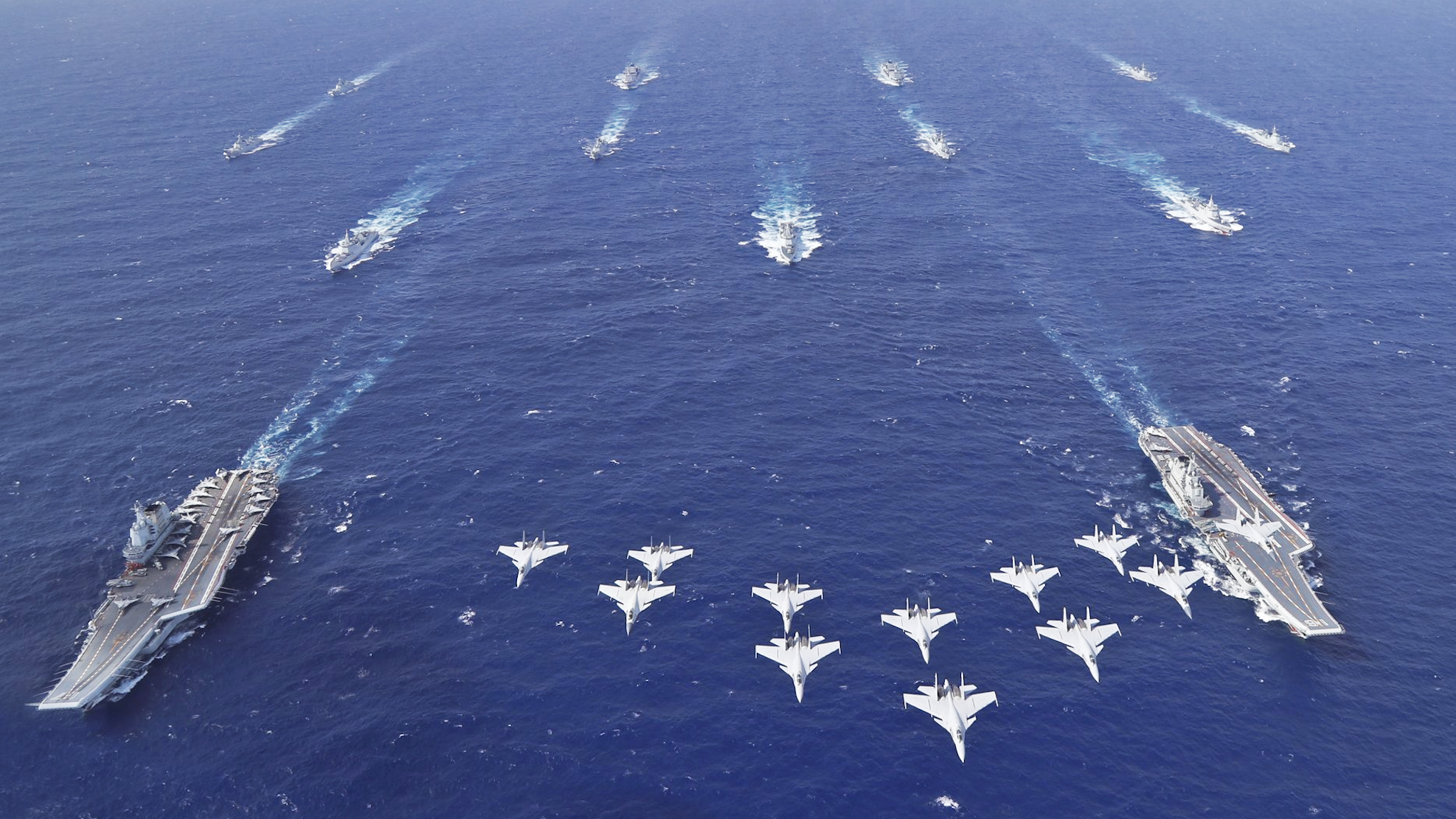The Chinese People’s Liberation Army Navy, or PLAN has for the first time conducted dual-carrier operations in the South China Sea. The drills, involving the country’s first two in-service carriers, the Liaoning and Shandong, as well as at least 11 other vessels, also showcased the PLAN’s fast-growing air wing. This revealed that both the upgraded J-15B single-seat multirole fighter and probably also the J-15D two-seat electronic warfare jet are likely now in operational service. Between them, these new versions of the J-15 Flanker carrier-based fighter point to the rapid progress made by the PLAN in developing more advanced aircraft that operate from its expanding aircraft carrier fleet.
Photos and a video of the dual-carrier maneuvers were recently released by Chinese state media, although it’s unclear exactly when they date from. While clearly engineered for public consumption — including a flyby conducted by a dozen J-15s overhead the flotilla — the photo opportunity also points to how the PLAN is developing its wider blue-water capabilities, including the vessels required to support carriers on long, out-of-area deployments. At the same time, the similarity between this photo exercise (PHOTEX) and the kinds staged by the U.S. Navy — including in the Indo-Pacific region — is remarkable.
The dramatic overhead formation of J-15 fighters — something that is also familiar from U.S. Navy PHOTEXes involving carriers — includes a group of 12 jets, also seen separated into six-ship flights. Meanwhile, another 18 J-15s were visible on the deck of the Shandong at the time of the flyby, with at least two more spotted on the Liaoning.
The fighters include both the original J-15 versions, which are equipped for short takeoff but assisted recovery (STOBAR) operations, and the more modern J-15B, which can also conduct catapult takeoff but assisted recovery (CATOBAR) operations. Bearing in mind the J-15B wasn’t known to be in operational service, the number of these particular versions involved (at least 15) makes it all the more notable.
The J-15B is significantly more capable than the earlier J-15 and J-15A. Its CATOBAR features were first tested on the J-15T prototype, which added a strengthened nose landing gear with an accompanying catapult launch bar. The series-production J-15B also has a new active electronically scanned array (AESA) radar (under a darker-colored radome, with no pitot tube) and a more modern cockpit. While most J-15Bs still retain the tried and tested AL-31F engines, this version has also been tested with domestically produced WS-10 turbofans.
Less obvious, however, are the two J-15D electronic warfare jets, broadly similar to the U.S. Navy’s EA-18G Growler, but likely also possessing a secondary strike mission. These are seen parked immediately alongside the island on the Shandong. While they appear to be distinguished by their tandem two-seat cockpits and humped forward fuselages, we cannot entirely rule out the possibility that these are single-seaters.

Reports suggest that the prototype J-15D first flew in late 2016. Like the land-based J-16D, this variant is characterized by large wingtip electronic warfare pods and it has the standard infrared search and track (IRST) sensor and cannon removed. Additional conformal and blade antennas are located around the airframe and further EW pods can be carried under the wings and below the fuselage.

Neither the Liaoning nor Shandong have catapults, but these are a feature of the new Fujian. Instead, the PLAN’s first two carriers use a ‘ski-jump’ takeoff ramp to launch fixed-wing aircraft.
A useful comparison of the Chinese aircraft carriers Liaoning (CV-16), Shandong (CV-17), and Fujian (CV-18):
As well as the two carriers, the maneuvers included an expanded surface action group, with various surface combatants and support vessels. This ships can be identified are three Type 055 Renhai class destroyers, four Type 052D Luyang III class destroyers, one Type 054A Jiangkai II class frigate, and two Type 901 Fuyu class fast combat support ships.
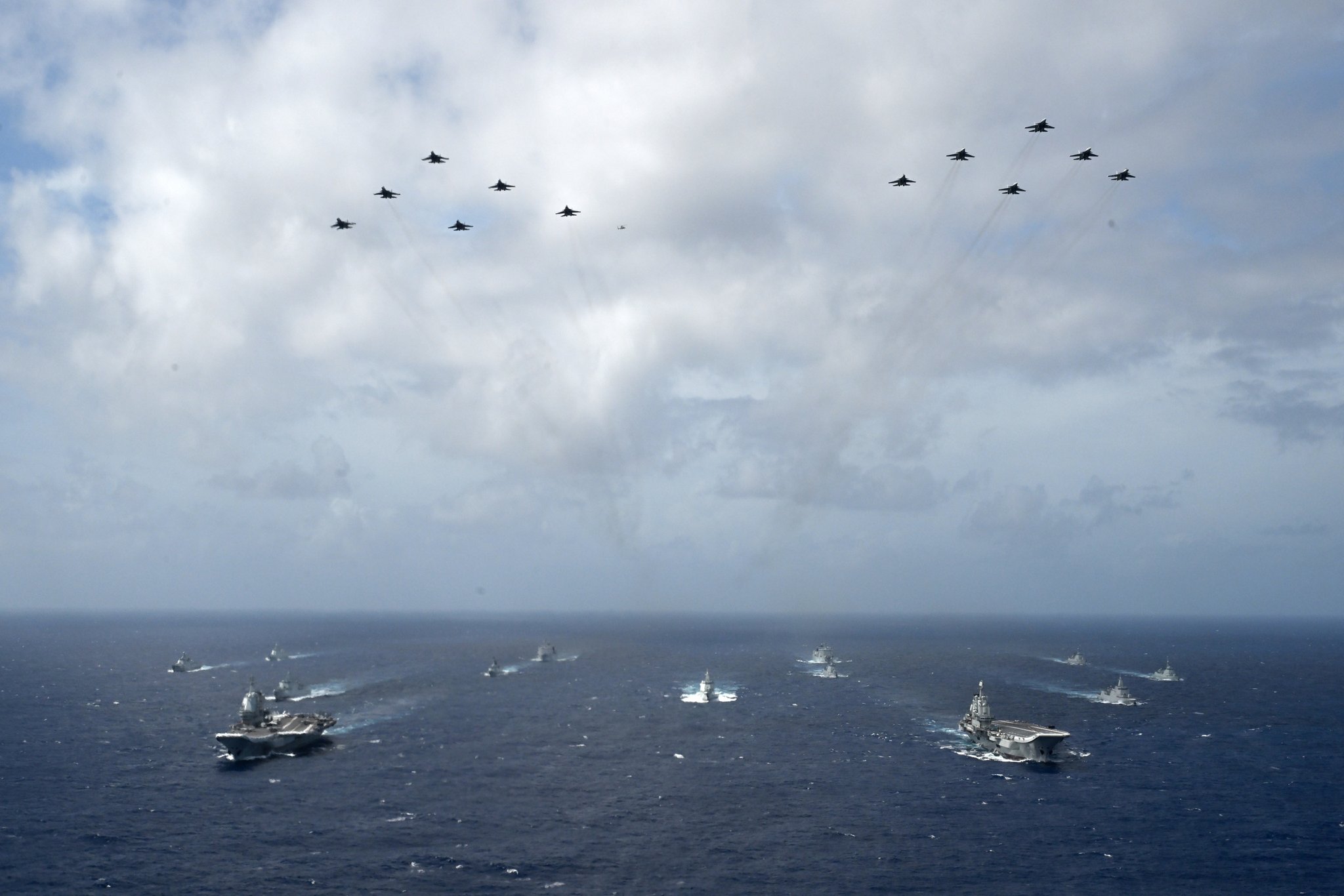
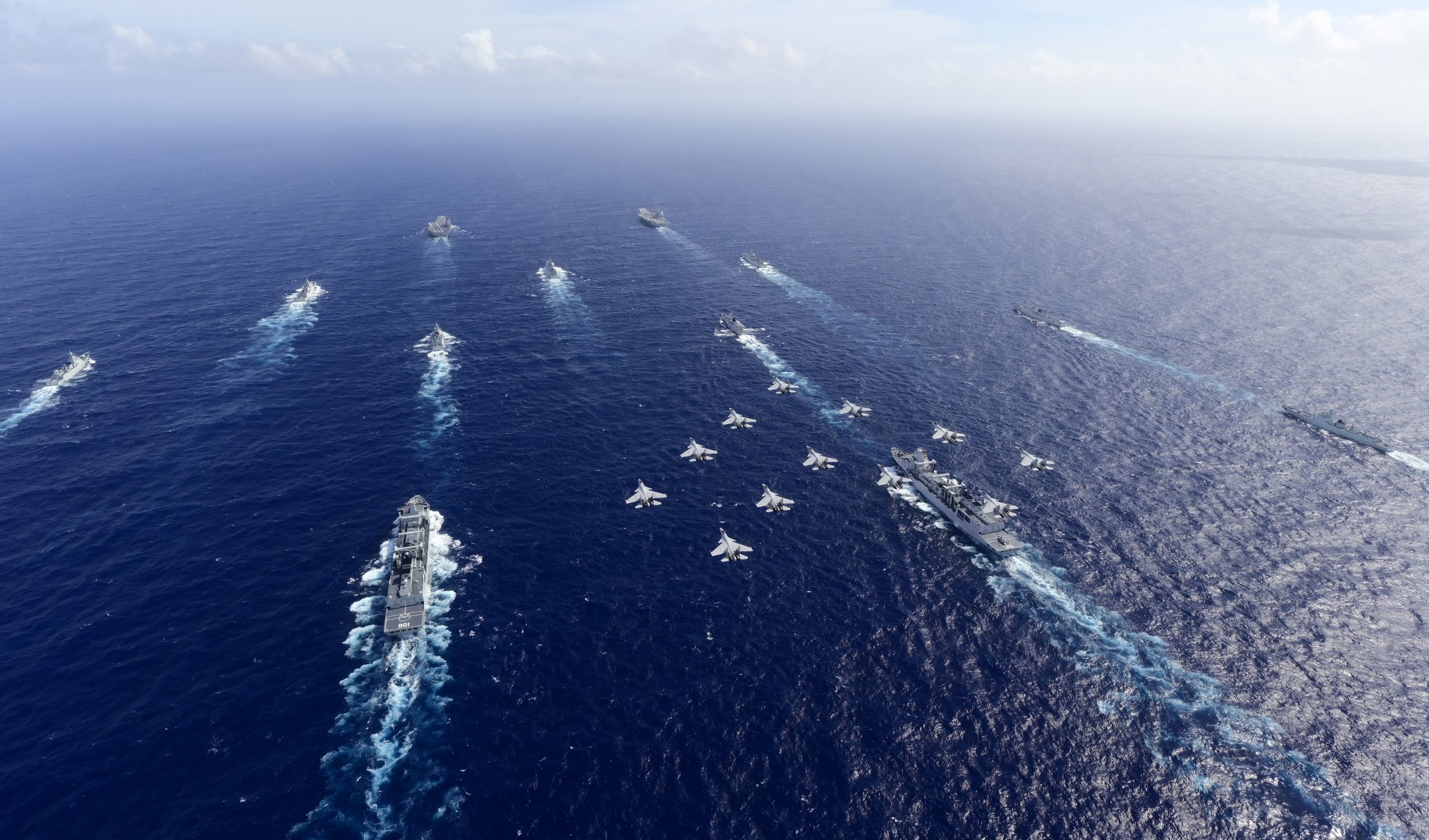
Typically, the Liaoning and Shandong go to sea with air wings made up of up to a maximum of 24 J-15 fighters. These are generally supported by around two Z-18F anti-submarine warfare helicopters, two Z-18JA airborne early warning helicopters, and a pair of smaller Z-9 helicopters for plane-guard and general utility duties.
It should be noted that the Liaoning and Shandong have been at sea simultaneously before but have never been seen in such close proximity. There were also reports last month that the PLAN put three aircraft carriers to sea at the same time, although one of these, the Fujian, is not yet operational, while the Liaoning and Shandong were operating a significant distance apart: in the Philippine Sea and off Hainan Island, respectively.
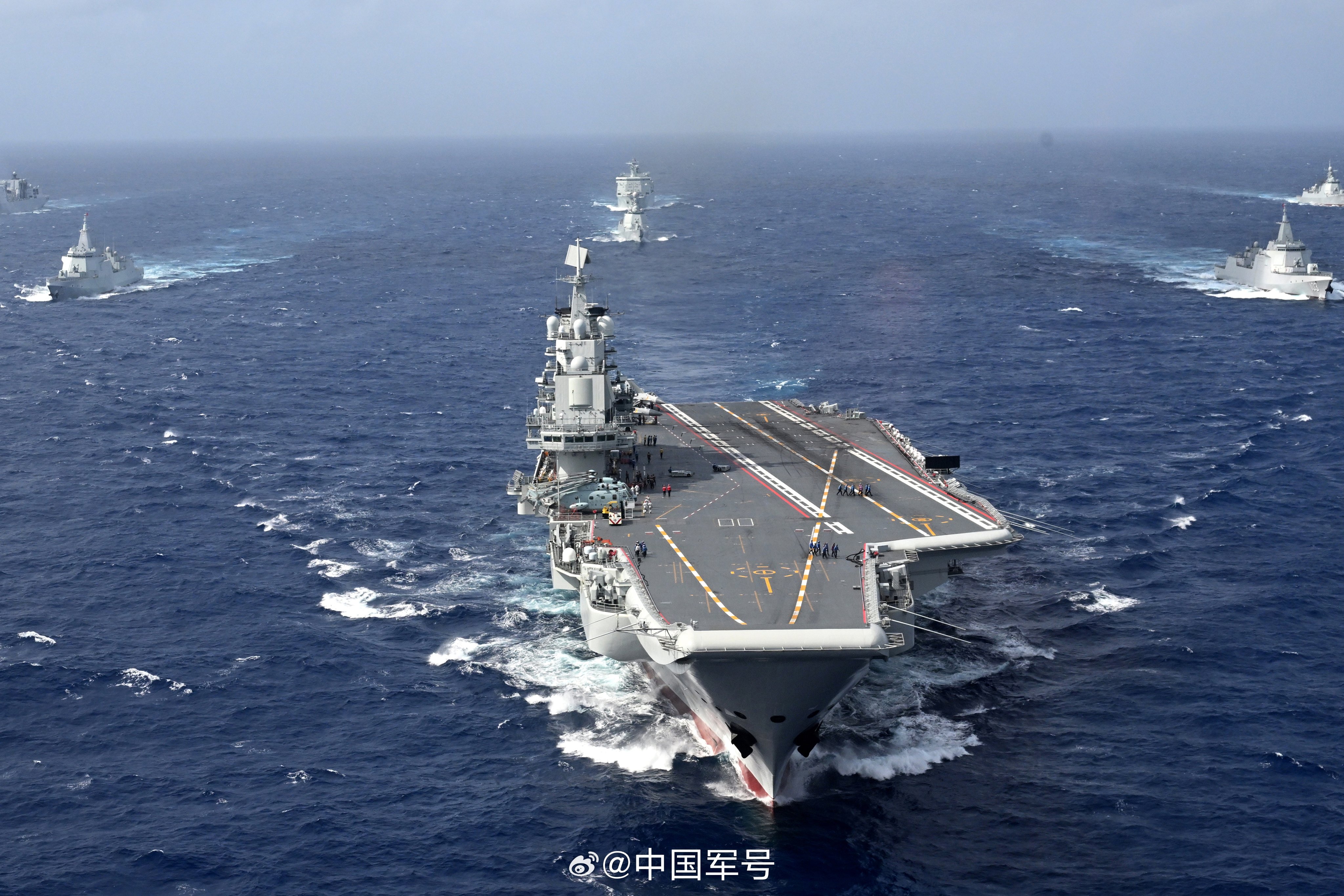
The fact that these recent maneuvers were documented in the highly strategic South China Sea is also no coincidence. Beijing claims almost all of these waters as its own, resulting in numerous disputes and standoffs with other nations in this region, and these kinds of naval drills are very much in keeping with China’s military signaling here.
Looking at the development of the carrier-based Flanker versions in more detail, the J-15 is the Chinese equivalent of the Soviet-designed Su-33 Flanker, a prototype of which China secured from Ukraine to assist in reverse engineering it. Unlike the Su-33, the J-15 has a multirole capability, since it incorporates avionics from the land-based J-11B fighter, although it retains the Russian-made AL-31F turbofans, unlike other Chinese Flanker versions now in production. The J-15A designation is sometimes applied to a slightly improved later-production version, with some additional precision-guided weapons options.

As for the new J-15B, as well as its enhanced capabilities, this provides the PLAN with its first experience of CATOBAR operations, which will be fundamental to getting the most out of its future carriers, starting with the Fujian, which is equipped with an electromagnetic aircraft launch system (EMALS), something that remains a relatively new and complex technology.
In the meantime, the J-15B and J-15D can clearly also be operated in STOBAR mode, which provides the air wings of the Liaoning and Shandong with a more capable fighter compared to the original J-15.
It should be noted that the PLAN is also exploring other carrier-based Flanker versions, to further expand the mission spectrum and capabilities of its carrier air wings. These include the two-seat J-15S, which some analysts assume will be initially used as a trainer, but which will likely also inform the development of a two-seat carrier-based multirole strike and electronic warfare platform, which may be designated J-17. A multirole-capable two-seater would also be relevant for other more complex missions, including long-range air defense or even working as a command and control platform for combat drones.
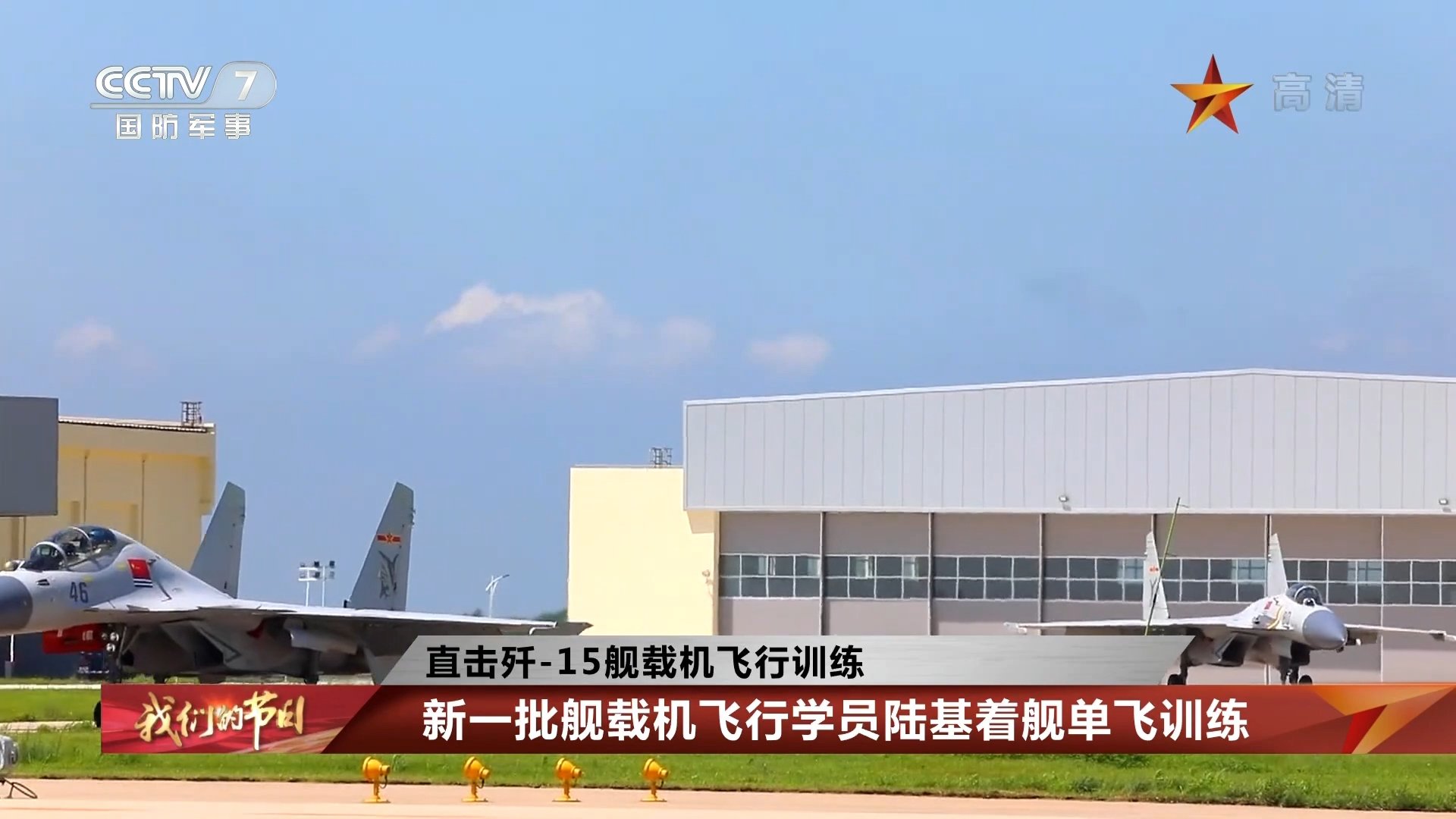
Ultimately, however, the CATOBAR-capable J-15 and other new Chinese carrier-based Flanker versions will likely be a stepping-stone toward the more advanced capabilities that will be offered by the PLAN’s next carrier fighter, the stealthy J-35, developed from the land-based FC-31.
While the J-35 was designed from the ground up for CATOBAR operations, aboard the Fujian and subsequent carriers, there are also signs that it, like the J-15B and J-15D, might also eventually embark on the Liaoning and Shandong.
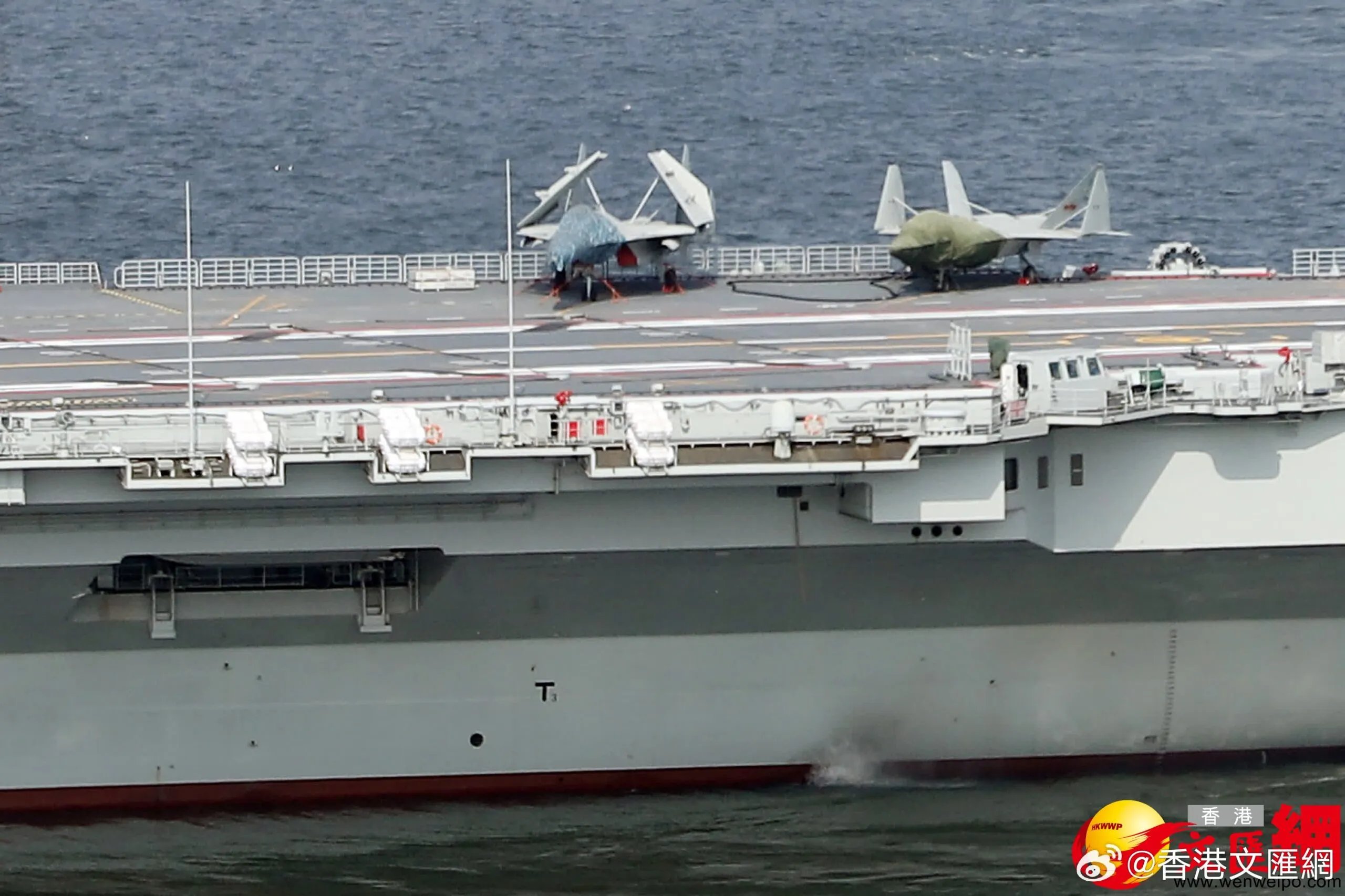
As we have discussed before, having the J-35 join the air wing of the Liaoning and Shandong would be a significant boost. In addition to its low-observable characteristics, it’s assumed that the production aircraft will feature an advanced AESA radar among a host of modern sensors and very capable weaponry.
The downside, as with putting the J-15B aboard the Liaoning and Shandong is that all these aircraft would have to launch off the bow ramp, limiting their payloads. However, as we’ve pointed out in the past, the J-35, which is intended to carry more limited stores internally, may be less dramatically affected than other types.

Perhaps most importantly, integrating the CATOBAR-capable J-15B and J-15D and perhaps also the J-35B into the air wings of China’s first two carriers will provide very valuable experience for pilots, maintainers, and the wider PLAN.
After all, the PLAN’s carrier aviation arm is still very much in its infancy, but it has bold ambitions. As well as the Fujian, which is now under test, and the J-35, the PLAN is looking forward to introducing the KJ-600 carrier-based radar plane, which will play a role analogous to the E-2 Hawkeye as a critical force-multiplier. The size and weight of the KJ-600 will preclude it from going to sea aboard the Liaoning and Shandong.
Carrier-based drones, including unmanned combat air vehicles (UCAVs), are also a growing area of interest for the PLAN and it’s now widely expected that the Fujian, at least, will eventually embark a low-observable UCAV that will offer strike, surveillance, and targeting capabilities.

After the Fujian, China is also widely expected to introduce more fully locally designed carriers, perhaps even with nuclear propulsion rather than the conventional powerplants used in its first three flattops.
In the meantime, the recent photo opportunity showing the PLAN’s dual-carrier operations and the expanding capabilities of its air wing, provide yet another indication of China’s expanding naval presence, especially in terms of its steadily growing carrier force.
Contact the author: thomas@thewarzone.com
